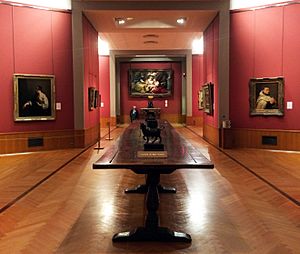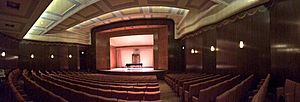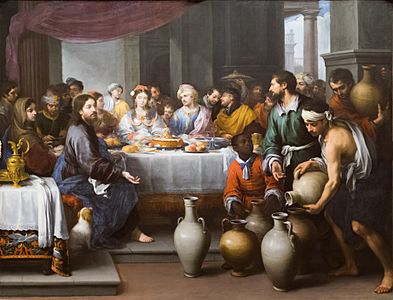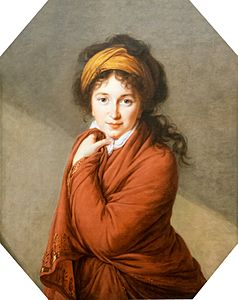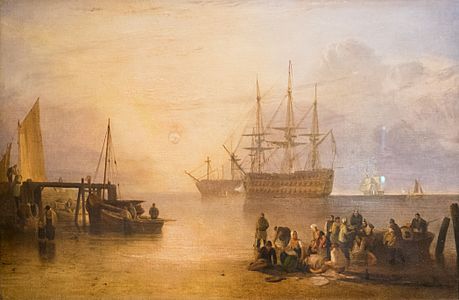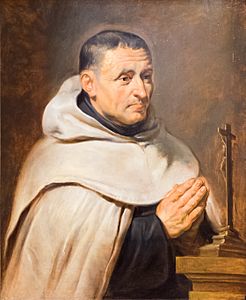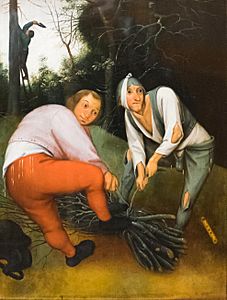Barber Institute of Fine Arts facts for kids
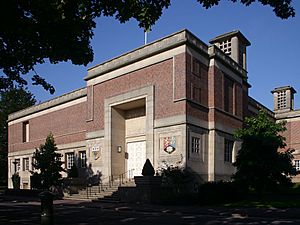 |
|
| Established | 1932 |
|---|---|
| Location | University of Birmingham Edgbaston, Birmingham B15, United Kingdom |
| Public transit access | |
The Barber Institute of Fine Arts is a cool place in Birmingham, England. It's both an art gallery and a concert hall. You can find it right on the campus of the University of Birmingham.
This special building was designed by Robert Atkinson in the 1930s. It has a unique style called Art Deco. The building first opened its doors in 1939, with Queen Mary herself there for the opening! It was the first building in the United Kingdom made just for studying art history.
The Barber Institute is really important. In 2005, a book called Britain's Best Museums and Galleries gave it five stars. This means it has "Outstanding collections of international significance." It was one of only five galleries outside London to get such a high rating!
Contents
Discover the Barber Institute
The Barber Institute is about 5 kilometers (3 miles) southwest of Birmingham city centre. It's located at the East Gate of the university campus. This museum holds one of the best art collections put together in Britain during the 20th century.
You can see amazing artworks by artists like Gwen John, André Derain, Fernand Léger, René Magritte, and Egon Schiele.
How the Barber Institute Started
The institute was created by a kind lady named Martha Constance Hattie Barber. She wanted to honor her husband, William Henry Barber, after he passed away. William Barber was a very successful property developer who made a lot of money building up Birmingham's suburbs.
Lady Barber came from an old family and had her own money too. The couple retired when they were in their mid-thirties. But they still cared a lot about Birmingham. In 1924, Henry Barber was given a special honor called a baronetcy for his help in the city.
Henry Barber died three years later. Lady Barber then decided to do something lasting for the city in his memory. On December 13, 1932, the Barber Institute of Fine Arts was officially started. Lady Barber gave it to the university to help people "study and encourage art and music."
Lady Barber passed away just four months later. She left all her money to the institute's trustees. This money was used to buy beautiful artworks for the collection and to build the new museum. To make sure only the best art was bought, the rules said that all purchases had to be as good as the art in the National Gallery or the Wallace Collection.
Leaders of the Institute
The first director, Thomas Bodkin, worked from 1935 to 1952. He gathered many of the first artworks. The Observer newspaper called this collection "the last great art collection of the twentieth century."
After him, Professor Ellis Waterhouse was director from 1952 to 1970. The current director is Nicola Kalinsky. She joined the Barber Institute when it was celebrating its 80th birthday.
The Building's Design
The Barber Institute building is very special. It was given a "Grade II listed" status in 1981. Then, in 2020, Historic England upgraded it to "Grade I," which means it's one of the most important buildings in the country.
The entrance area, including the floor and staircase, is made of a beautiful stone called travertine marble. The main concert hall is covered in Australian walnut wood, making it look very grand.
The institute closed temporarily on October 2, 2023, for some updates. It plans to open again in June 2024.
Amazing Art Collections
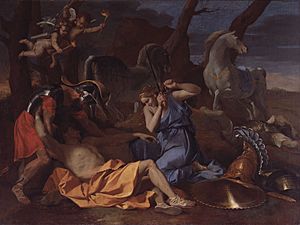
The Barber Institute has many famous artworks. You can see pieces by artists like Vincent van Gogh, Claude Monet, Auguste Rodin, J. M. W. Turner, and Rubens. These are shown in large, elegant galleries on the first floor.
Art Through the Ages
- Renaissance Art: This older period is shown with amazing works by Sandro Botticelli, Giovanni Bellini, Veronese, and Simone Martini. For example, Martini's St John the Evangelist from 1320 is there.
- 17th Century Art: You'll find art from this time by artists such as Rubens, Van Dyck, Poussin, and Murillo.
- Impressionism and Post-Impressionism: These art styles from France are well-represented. You can see paintings by Degas, Monet, Renoir, Van Gogh, and Gauguin.
- British Artists: The collection also includes works by famous British artists. These include Aubrey Beardsley, Gainsborough, Reynolds, Rossetti, Whistler, and Turner.
Other Treasures
The institute also has a great collection of sculpture. This includes pieces by Rodin and Degas. There are also old master prints and drawings. You can see tiny portrait miniatures and other beautiful objets d'art.
Right at the entrance, you'll see the Equestrian Statue of George I. This is the oldest public sculpture in Birmingham!
In 2013, the gallery bought an important painting by Sir Joshua Reynolds. It's called Maria Marow Gideon (1767–1834) and her Brother William (1775–1805). In 2015, they got Miss Bentham (1906) by George Bellows. This was their first American painting.
Coin Collection and Music
The Barber Institute has one of the biggest coin collections in the world. It's especially strong in Roman and Byzantine coins. In 1967, the collection grew a lot with 15,000 more coins!
Many concerts happen at the Barber throughout the year. There's also a music festival held every June. The Barber's music library also holds 860 items from the Shaw-Hellier collection.
Famous Artworks to See
- The Harvest Wagon by Thomas Gainsborough
- Symphony in White, No. 3 by Whistler
Gallery
-
The Marriage Feast at Cana (Bartolomé Esteban Murillo, about 1672)
-
Portrait of Countess Golovina (Elisabeth Vigée-Lebrun, about 1797–1800)
-
The Sun Setting through Vapour (Joseph Mallord William Turner), about 1809
-
Portrait of a Carmelite Prior (Peter Paul Rubens), about 1616
-
Two Peasants Binding Faggots (Pieter Brueghel the Younger), about 1620


